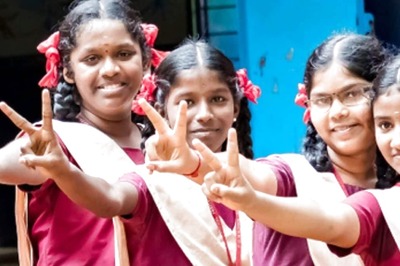
views
The battle for 2019 has officially commenced with electors casting their votes in 91 constituencies across 20 states in the first phase of Lok Sabha elections on Thursday. Among these 91 constituencies, eight seats fall in the politically crucial Uttar Pradesh’s western region.
All of these eight constituencies—Baghpat, Bijnor, Gautam Budhha Nagar, Ghaziabad, Kairana, Meerut, Muzaffarnagar, and Saharanpur — were won by the Bharatiya Janata Party (BJP) in the previous parliamentary elections amid the 2014 ‘Modi wave’. The party had secured a massive vote share of 48.96 per cent in these eight seats — 6.90 percentage points more than the party’s overall votes in the state which was 42.6 per cent.
The Samajwadi Party (SP) and Bahujan Samaj Party (BSP) were at a distant second and third spot with 18.71 per cent and 18.62 per cent of votes on these eight seats. Congress, on the other hand, received 10.92 per cent of votes in the seats.
However, in 2009, while the BSP had won four of these constituencies, two seats each were bagged by BJP and Ajit Singh’s Rashtriya Lok Dal (RLD).
Popularly known as the Jat-belt of the state, Jats, Muslims, and Dalits form a sizeable share of the electorate on these seats in Western UP, and have the potential to influence the results.
The RLD, which has a significant vote-base among the Jat community, is believed to have strong influence in the region. As per the current scheme of things in the SP-BSP-RLD mega-alliance, RLD’s Jayant Chaudhary is contesting from Baghpat, while his father and the party chief Ajit Singh is in the fray from Muzaffarnagar.
The region is also considered to be highly polarised, especially after the Muzaffarnagar communal violence in 2013, which claimed nearly 62 lives and lead to the displacement of more than 50,000 people. The impact of the polarized atmosphere was visible in the voting-patterns of the constituency during the 2014 Lok Sabha polls.
Booth level data available for election in Muzaffarnagar constituency in 2014 suggests that villages and areas falling under a booth voted sharply one way or the other. In majority of the booths, the winning party—BJP in this case — gathered a very high vote-share, often in excess of 90 per cent.
Coupled with the ‘saffron wave’, this polarization lead to Sanjeev Kumar Balyan of the BJP winning the seat with a vote-margin -- more than that of the Prime Ministerial candidate Narendra Modi himself.Vote-Swing and the Kairana By-poll
As per the Census 2011, these eight constituencies have an average Muslim population of 30-35 per cent. This is perhaps the highest concentration of Muslims in the state. Coupled with the Scheduled Castes, including Dalits, they make up for a near majority of the electorate on these seats.
Hence, there’s no denying that the SP-BSP-RLD alliance would look to consolidate these votes in order to dethrone the BJP in these constituencies. Moreover, with RLD in the fray, if the alliance is able to bring Jat votes into its fold, the combination could prove to be a formidable one.
A simple summation of these three parties on these eight seats in 2014, shows that had they joined hands then, they would’ve won three of them. However, on a more realistic level, last year’s Kairana bypoll could be seen as a better indicator of how the alliance might actually work on the ground.
The Kairana seat was won by the BJP in 2014 with a vote-share of 50.6 per cent, while the combined votes of SP-BSP-RLD accounted for 47.5 per cent, making it a margin of 3.1 per cent.
During the bypoll in May last year, backed by SP, BSP and the Congress, RLD candidate Tabssum Begum trounced the BJP’s Mriganka Singh. Tabassum received 51.49 per cent of the total valid votes, whereas Singh collected 46.72 per cent of the votes. In the process, BJP lost 3.88 per cent of the vote-share and the opposition candidate gained 3.66 per cent, making it a 4 per cent of vote-swing.
If this swing persists in Kairana (Tabassum Begum is again in the fray on an SP ticket) and the rest of these seats, then the alliance could be looking at a good push early in the Lok Sabha elections.
Sanjay Kumar, professor and director at the Centre for Studies of Developing Studies (CSDS), said that the alliance poses a tough challenge to the BJP and is pushing the party back.
“Only question is whether BJP will be pulled down [in terms of total seats]. I think there is a very close contest between the alliance on the one hand and BJP on the other hand. [While], I think the alliance has an edge in the state, it will still be a close call,” Kumar said.Rural Seats and Sugarcane Dues
Of these eight constituencies, three are categorized as rural, whereas the remaining five are semi-urban in terms of demography. Therefore, the issue of farmers’ distress could play a role in on these seats.
For instance, according to UP government’s data, there were at least Rs 9,595 crore worth of dues for 2018-19 season. The arrears jump to Rs 10,636 crore as of April 9, 2019, when the dues from the previous season of 2017-18 are added. Interestingly, nearly half of this amount is due by mills located in six of the eight constituencies that are polling in the first phase, as per media reports.
“In a state, even when there is farmers’ distress and people are looking for change, if they don't see an alternative, then some of those voters who may have not wanted not to vote for the BJP may still vote for the party. However, this is not the case in Western UP. Here, people see an alternative,” Kumar told News18 while talking about farm distress being a factor in the region, as well as the entire state.Congress’ Only Shot
Congress had a meagre overall vote-share of 10.92 per cent on these eight seats in 2014 and has even been left out of the mega-alliance of SP-BSP-RLD. However, even in this over all abysmal show on these seats, grand old party’s Imran Masood still managed to poll 34.2 per cent of the valid votes from Saharanpur, trailing only by 5.4 per cent of the votes.
In 2014, BJP’s Raghav Lakhanpal had won the Saharanpur constituency. Lakhanpal has been again nominated by the party this time around. Similarly, Congress has again fielded Masood against him.
Imran is considered as a grass-roots worker in the constituency. His father Rasheed Masood, who has been a veteran in this constituency, had won the seat in 2004 Lok Sabha elections on an SP ticket, while he was the runner-up in 1999 and 2009 from the same party. Rasheed also represented the constituency in 1977 for Bharatiya Lok Dal (BLD), and in 1989 and 1991 for the Janata Dal (JD).
On Tuesday, the Congress ended its campaigning in the constituency with a roadshow by Priyanka Gandhi Vadra. Although its chances are bleak on the remaining seven seats in the first phase, the party would be hoping to run an extra-mile to secure the seat for itself.


















Comments
0 comment